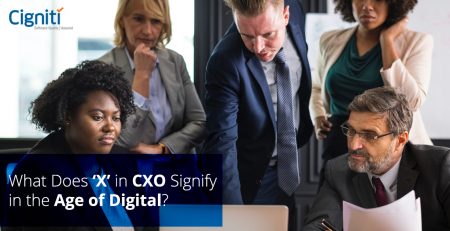MultiExperience for Enterprise Digital Transformation in 2024
|
Listen on the go!
|
Gartner has placed Multiexperience amongst the top technology trends of 2020. According to the analyst, the multiexperience trend will replace technology-literate people with people-literate technology. Instead of people getting accustomed to evolving technologies, technology will evolve to better understand people.
Multiexperience is about leveraging various modalities, digital touchpoints, apps, and devices to design and develop a seamless customer experience. The idea is to interact with customers at as many touchpoints as possible to offer a consistent customer experience across the web, mobile, app, and other modalities.
Gartner predicts that by 2023, more than 25% of the mobile, progressive web, and conversational apps at large enterprises will be built and run through a multi-experience development platform. Multiexperience technology is a step ahead in the journey of complete digital transformation. As businesses invest in state-of-the-art digital solutions to develop smooth experiences for their consumers, multiexperience may be the catalyst for guaranteeing fruition.
Daniel Sun, VP Analyst at Gartner, says, “Development teams should master mobile app design, development, and architecture because ‘mobile’ is typically the gateway to multiexperience.” Businesses looking to design multi experience should consider technologies such as Augmented Reality, Virtual Reality, Mixed Reality, wearables, chatbots, IoT. These technologies, along with apps, websites, and social media channels, will assist in developing a whole multiexperience.
Mind you, multiexperience is not omnichannel
Thinking of multiexperience as being the same as omnichannel is a rather common mistake. While omnichannel involves tapping the user touch points across all the channels, multiexperience is about developing effortless customer experiences across apps, websites, and modalities of voice, touch, and text, irrespective of the channel.
The key difference between omnichannel and multiexperience is the core. Omnichannel is all about technology, whereas multiexperience is all about people. This difference marks the shift from technology-literate people to people-literate technology.
The four-step multi experience model
Jason Wong, Research Vice President at Gartner, proposes a four-step model for applying multiexperience to a digital user journey:
- Sync me: Storing a user’s information, which the user can find and access anytime.
- See me: Understanding a user’s context, location, situation, and historical preferences and then offering better information and interaction to the user.
- Know me: Using predictive analytics to make suggestions to the user
- Be me: Acting on the user’s behalf when given permission and making the best decision for the user.
The stored information about users can help businesses understand their likes and preferences in various contextual situations. This would then enable them to implement predictive analytics and offer recommendations to users for their next course of action.
“Development platform vendors are expanding their value proposition beyond mobile apps and web development to meet user and industry demands. The result is the emergence of multiexperience development platforms, which are used in developing chat, voice, augmented reality (AR), and wearable experiences to support the digital business,” says Wong.
Although mobile apps remain the most common type of applications enterprises deploy besides their website, cloud-hosted Artificial Intelligence (AI) services such as conversational user interfaces, image recognition, and voice recognition are among the most commonly used technologies for developing multiexperiences. An enterprise must have a well-crafted multiexperience development strategy to scale digital initiatives. However, one fundamental barrier in the process is the business and IT alignment gap, which is further widened by the developers’ lack of user experience expertise.
Domino’s – leading the digital race with multiexperience
Domino’s strives to change the game of customer experiences using innovative solutions. Over the past few years, Domino’s has invested in cutting-edge technologies to fulfill its mission of becoming the best pizza delivery company in the world. The multinational pizza restaurant chain is among the pioneers of multiexperience development.
Domino’s Anyware™ allows users to order pizzas on their favorite devices. The customers can order their choice of pizza via:
- Google Home: By simply saying, “Ok, Google, talk to Domino’s,” customers can create a new order, place their Easy Order, reorder their most recent order, and track it using Domino’s Tracker®.
- Amazon Alexa: Ordering on Amazon Alexa works the same as Google Home. Alexa can hear the users’ voices from across the room, so they can place their order without getting up.
- Slack: By installing the Domino’s app in the Slack workplace application, users can send a direct message to place an order.
- Facebook messenger: Users can order their preferred pizza in seconds using the messenger bot.
- Zero click: This customized application allows users to place their ‘Easy Orders’ after a 10-second countdown without a single click.
- Text: Domino’s also leverages text or messaging platforms where users can initiate their order by simply sending a pizza emoji.
- Tweet: Users can tweet a hashtagged post and tag the Domino’s account.
- Car: Ford owners can open the Domino’s app and place their orders using the Ford SYNC® Applink™.
- Smart TV: The Domino’s app for Samsung Smart TVs enables users to place their favorite orders while watching their favorite show.
- Voice: Domino’s intelligent assistant, Dom, is integrated into the Domino’s app for Android and iOS. Customers can place an order using their voice.
- Smart Watch: Apple Watch® and ANDROID WEAR® allow easy order placing and tracking.
In addition to all these platforms, Domino’s is also working on getting CAA approvals for its pizza-delivery drones. It has created the first autonomous pizza delivery vehicle, the Domino’s Robotic Unit, or DRU.
Digital assurance for assured multiexperience
Building digital automation and operations is becoming imperative to sustain digital transformation. Digital transformation for the future is marked by the shift from mobile to multiexperience. Now, enterprises looking to accelerate their digital journey must rethink their transformational strategy. This would require them to place their customers at the center of the transformation. The technology they use should facilitate creating genuinely seamless customer experiences. Multiexperience-driven digital transformation necessitates a three-part customer strategy that involves the physical, contextual, and experiential aspects for the users to enjoy a smooth journey.
With the rising demand for multiexperience, the need for digital assurance is also rising. Enterprises are demanding software testing services to facilitate accelerated speed-to-market while allowing them to embrace newer technologies.
Cigniti’s testing solutions address the multifaceted needs of digital transformation testing. We assure digital transformations by conducting comprehensive testing across your digital value chain, encompassing digital marketing, web portals, web content, digital assets, web analytics, and the entire digital ecosystem – which includes cloud, mobility, big data, and connected devices. Connect with us today.





Leave a Reply